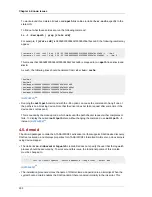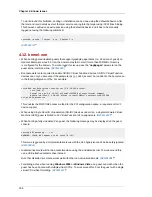
kvm
305
• Devices using the qlge driver cannot be assigned to a KVM guest using KVM's PCI Device Driver
assignment.
(BZ#507689)
77
• the use of the qcow2 disk image format with KVM is considered a Technology Preview.
(BZ#517880)
78
• Hotplugging emulated devices after migration may result in the virtual machine crashing after a
reboot or the devices no longer being visible.
(BZ#507191)
79
• Windows 2003 32-bit guests with more than 4GB of RAM may crash on reboot with the default
qemu-kvm CPU settings. To work around this issue, configure a different CPU model on the
management interface.
(BZ#516762)
80
• The KVM modules from the
kmod-kvm
package do not support kernels prior to version
2.6.18-159.el5. Error messages similar to the following will be returned if attempting to install these
modules on older kernels:
FATAL: Error inserting kvm_intel
(/lib/modules/2.6.18-155.el5/weak-updates/kmod-kvm/kvm-intel.ko): Unknown
symbol in module, or unknown parameter (see dmesg)
(BZ#509361)
81
• the kvm package has incorrect dependencies related to the
libgcrypt
package. Consequently,
if the
libgcrypt
package installed on a system is earlier than version 1.4.4, the
qemu-kvm
process may refuse to start, returning a
libgcrypt initialization error
message. To work
around this issue, update
libgcrypt
to the version provided by Red Hat Enterprise Linux 5.4.
(BZ#503118)
82
• The KVM modules available in the
kmod-kvm
package are loaded automatically at boot time if the
kmod-kvm package is installed. To make these KVM modules available after installing the
kmod-
kvm
package the system either needs to be rebooted or the modules can be loaded manually by
running the
/etc/sysconfig/modules/kvm.modules
script.
(BZ#501543)
83
• Some Linux-based guests that use virtio virtual block devices may abort during installation, returning
the error message: unhandled vm exit: 0x31 vcpu_id 0 To work around this issue, consider utilizing
a different interface (other than virtio) for the guest virtual disk.
(BZ#518081)
84
• RHEL5.x virtualization relies on etherboot for remote booting. Etherboot is an implementation of the
pxe standard, but lacks some features that are present in the new gpxe boot technology which is not
shipped with RHEL. It is possible to use the gpxe roms with RHEL 5.4. As an example, gpxe roms
can be used to interpret requests generated by Microsoft RIS or WDS. All components present in
RHEL5.4 are capable of booting gpxe roms. The roms can be obtained directly from http://rom-o-
matic.net/, or other sources like the Fedora Project.
BZ#509208
85
• The Preboot eXecution Environment (PXE) boot ROMs included with KVM are from the Etherboot
project. Consequently, some bug fixes or features that are present on the newer gPXE project
are not available on Etherboot. For example, Virtual Machines (VMs) cannot boot using Microsoft
based PXE (ie. Remote Installation Services (RIS) or Windows Deployment Services (WDS)).
(BZ#497692)
86
• The following QEMU / KVM features are currently disabled and not supported:
(BZ#512837)
87
• smb user directories
Summary of Contents for ENTERPRISE 5.4 RELEASE NOTES
Page 1: ...Red Hat Enterprise Linux 5 4 Technical Notes Every Change to Every Package ...
Page 18: ...xviii ...
Page 306: ...288 ...
Page 464: ...446 ...
Page 466: ...448 ...
















































